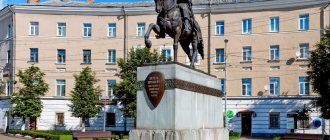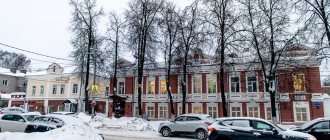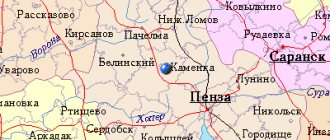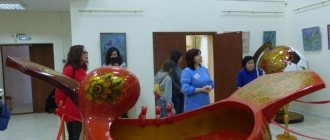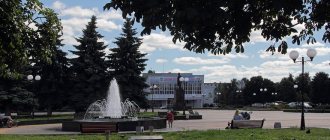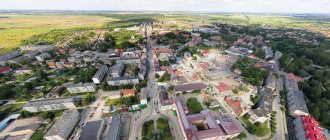general information
Zubtsov is one of the oldest Russian cities, dating back to the beginning of the 13th century. It carefully preserves its glorious history and traditions, attracting tourists with interesting monuments of the 17th-19th centuries. Notable among them are the impressive 17th-century Cathedral of the Assumption of Our Lady and the well-preserved 19th-century City Estate complex. Lovers of antiquity will be interested in the remains of a fortified settlement of the 12th century, and connoisseurs of Russian landscapes will be interested in picturesque parks, numerous springs and stunning views of the city from the observation deck located at the Military Glory Memorial. In the historical center of the city there is the Zubtsovsky Museum of Local Lore, the extensive exhibition of which reflects the history of the region from the period of its settlement to the middle of the 20th century. Zubtsov is a picturesque area offering ample opportunities for fishing, boat trips, hiking and picnics. Since 1999, the city has hosted the annual Interdistrict Festival of Author and Bard Songs. In addition, Zubtsov is the industrial center of the Tver region with a developed infrastructure - there are mechanical repair and engineering plants, a dam on Vazuza, a processing plant, cultural institutions and banks.
Zubtsov: on the banks of the Volga and Vazuza
Photo by Yuri Zaitsev
We continue the series of publications dedicated to the cities of the Tver region.
The current Zubtsov is a quiet provincial town with a population of no more than six and a half thousand people. But like many other settlements in our region, it has a rich history dating back centuries.
There were also legends
Zubtsov was first mentioned in chronicles in 1216, and therefore its age can be considered quite respectable - this city recently celebrated its 800th anniversary. However, you and I understand that in fact it is even older, because in the historical document Zubtsov already appears as an existing fortress, which was taken by storm by Mstislav Udatny, the prince of Toropetsk and Novgorod.
Let us recall that in the Middle Ages Rus' was fragmented into numerous appanage principalities, quite small by modern standards. Cities often changed hands, princes fought with each other, made and broke alliances - in general, political life, as they say, was in full swing. And Zubtsov, due to its advantageous geographical location, also often became a stumbling block for the ruling persons. Foreigners, in particular Tatars and Lithuanians, did not bypass this city either.
We will return to this later, but first let’s talk a little about the history of the city. A number of historians, in particular Vladimir Andreevich Kuchkin, adheres to the version that Zubtsov was founded by Vsevolod the Big Nest, the Grand Duke of Vladimir. At that time it was an outpost marking the western edge of the Rostov-Suzdal land.
The city became part of the Tver Principality in 1247. This happened after the murder of the Vladimir prince Yaroslav Vsevolodovich in the Horde - in accordance with the will, his sons received their inheritance. Here the opinions of historians differ slightly: for example, Andrei Vasilyevich Ekzemplyarsky and Alexander Evgenievich Presnyakov believed that Tver (and with it Zubtsov) went to Yaroslav Yaroslavich, and Pereslavl - to Alexander Yaroslavich (Nevsky). According to Kuchkin, who did a lot of research work with chronicle sources, at first everything was the other way around. And only in 1252 Alexander gave Tver to Yaroslav, and took Pereslavl for himself. Be that as it may, all the Tver princes were ultimately descendants of Yaroslav Yaroslavich. He himself is considered the first independent prince of the Tver lands.
In 1319, the territory of the Tver Principality was divided between the sons of Mikhail Yaroslavich, who was killed a year earlier in the Horde. The capital city itself with the adjacent volosts went to Dmitry Mikhailovich, the eldest son of the prince, Klin - to Konstantin, Kashin - to Vasily, and Zubtsov, along with Kholm, Staritsa (which was then called Gorodok) and Mikulin - to Alexander. As a result of this division of the territory, Zubtsov became the center of a small appanage principality.
Let us recall, by the way, that Kholm also remained in history as the capital of one of the independent fiefs, ruled by Vsevolod Alexandrovich, the son of Alexander Mikhailovich. Today this is the small village of Krasny Kholm on the territory of the Zubtsovsky district, and in the Middle Ages in its place there was a full-fledged city for those times - we emphasize once again, the capital of the appanage principality. We have already written about this in detail in one of the previous materials dedicated to Staritsa.
But if we are already talking about the existence of princely appanages on the modern Zubtsovsky land, then the Principality of Fominsk is worth mentioning separately. The first mention of its center, Fomin Gorodok, dates back to 1371. The principality itself was an inheritance of the Smolensk land, and the main part of its territory was located between Sychevka and Zubtsov. Its dimensions were quite tiny; this lot is considered one of the smallest in Rus'. Nevertheless, it was an independent state entity that controlled one of the options for the water route from Novgorod to the south.
Zubtsov in 1910, photo by S.M. Prokudin-Gorsky
The capital and residence of the Fominsk princes was located at the confluence of the Osuga River with the Vazuzu. After the 15th century, the principality and, accordingly, the city ceased to be mentioned in written sources, and the village of Fomino-Gorodishche arose on the site of the former capital city. In the seventies, this place was partially flooded during the construction of the Vazuz reservoir. However, Fomino-Gorodishche, which belongs to the Zubtsovsky district, exists to this day, reminding us of the medieval fortress and the small proud principality founded, according to legend, by the hero Thomas.
Let's return to Zubtsov. The independent principality with its center in this city did not last long - from 1319 to 1364-1365. Then it was revived again in 1426, after the death of Yuri Alexandrovich, the Grand Duke of Tver. Boris Alexandrovich, his brother and successor, granted the Zubtsovsky inheritance to his nephew Ivan Yuryevich. The latter died childless around 1460, and Zubtsov again moved to Tver. And in 1485, the Grand Duchy of Tver lost its independence, becoming part of the Moscow Principality.
By that time, Zubtsov was not just an important fortress, but also quite a large city. Thus, according to treaty documents with Lithuania dating back to the 14th century, in terms of payment of trade duties it was equal to Tver and Kashin. The latter, we recall, was also a fairly developed city and even competed with the capital of the grand duchy.
As we have already said, Zubtsov’s existence could not be called peaceful - the city was attacked by Tatars and Lithuanians at different times, and it also suffered in the confrontation between Tver and Moscow. During the Time of Troubles, Zubtsov also suffered greatly - the Poles and Tushins, supporters of False Dmitry II, managed to manage it. However, the city survived, despite all the hardships.
The rich history of ancient Zubtsov is quite predictably overgrown with traditions and legends. And one of them concerns its name. In fact, why Zubtsov? There is a belief that brothers from Novgorod settled in the newly formed trading hub. Their names were Obryak, Vetran and Zubets. The city was allegedly named after the latter. But there is also a more realistic version, albeit less romantic: Zubtsov received its name due to the fact that it arose on a triangular cape formed at the confluence of two rivers - the Volga and Vazuza. Hence the “prong” and, as a consequence, Zubtsov. No one knows exactly what happened in reality, so everyone is free to choose the version that he likes best.
From the Russian Empire to the Red Empire
Our regular readers have long been aware that in the 18th century in Russia administrative-territorial units were repeatedly changed and redrawn. Before Peter’s reforms, our country was divided into counties, volosts and so-called categories, and in 1708 the first eight provinces appeared. Let us remember that these were Ingermanland (later St. Petersburg), Moscow, Arkhangelsk, Smolensk, Kiev, Kazan, Azov and Siberian.
The old administrative-territorial division was largely based on the former princely appanages, and therefore by the beginning of the eighteenth century it was significantly outdated. The counties were uneven in area, and the relationship between the capital and the province was extremely complicated. It was these reasons, as well as the need to create a new system of financing the army and navy in the conditions of the Northern War, that prompted the sovereign to update the principles of the internal division of the country.
The next reform was carried out in 1719 - now the provinces were divided into provinces, and the latter into so-called districts. From that moment on, the province was considered the highest regional unit, and the provinces now served as military districts. The governors at the head of the provinces reported to the Senate on civil matters, but the governors could demand their submission only in military matters.
Until 1727, the territorial division of the country did not undergo any significant changes, only some previously abolished provinces were restored, a new Revel province was formed with forty-seven provinces, and Azov was renamed Voronezh. But then the administrative-territorial issue was revised again. In particular, it was decided to abandon the districts and return the counties. The boundaries of these entities were also revised, but in many cases they remained the same or underwent minor transformations. In addition to everything, two new provinces appeared - Novgorod and Belgorod.
Then the leapfrog stopped for a while - until 1775, the internal structure of the Russian Empire remained relatively stable, and new provinces, as a rule, were formed in new territories annexed to our country.
Another major reform was carried out by Empress Catherine II. In accordance with her decree, over the course of a decade (from 1775 to 1785), the size of the provinces was reduced, provinces were eliminated, and the boundaries of counties were changed. Everything was carried out in a different way: it was specially calculated that 300-400 thousand people would live in the province, and from 20 to 30 thousand in the district. As a result of the reform, a new territorial unit also appeared - the governorship. If its territory was large, then it was divided into regions. Such drastic changes were dictated, among other things, by the desire to strengthen local power after the Pugachev rebellion, or rather, the entire Peasant War.
Another revision of the territorial division took place at the end of the century under Paul I, who officially renamed the governorships into provinces, and these administrative entities themselves were enlarged. The same thing happened with the counties. Subsequently, the internal division of the Russian Empire also changed several times, but this is a topic for a separate article.
Zubtsov was assigned to the Tver province under Peter I, and in 1776 it became a district town of the Tver governorship. The Zubtsovsky coat of arms with a fortress wall was established in 1780. When the governorship was renamed into a province (remember, this happened in 1796), Zubtsov and the district remained within its borders.
Until the revolutionary change of power in our country, Zubtsov remained a fairly wealthy merchant city. Ever since the construction of the Vyshnevolotsk water system, it became an important transshipment point on the waterway to the imperial capital, and barges from Rzhev went through Zubtsov to Moscow and Tver. At that time, flax was highly valued, which can rightfully be compared with oil in terms of the driving force of the economy. Demand always exceeded supply, and therefore flax growing was one of the thriving industries in Tsarist Russia. Note that this culture was used to produce not only fabric, but also oil. So Zubtsov, with its advantageous geographical position and developed flax growing, was a real merchant center, very important for that era. Moreover, a significant share of raw materials was exported.
Zubtsov was also known as a venue for large fairs, and the first places in trade were, naturally, flax, as well as livestock, products of tanners and potters. The largest population of pre-revolutionary Zubtsov was reached in 1890 - according to the census, 4,337 people lived in it.
Photo by Yuri Zaitsev
Then difficult times came for Russia. Famine, the Russo-Japanese War and the First Russian Revolution, the Great War, later called the First World War, then the February Revolution and, finally, the October Revolution with the ensuing Civil War, another famine and devastation. The country was on the brink of destruction, plunged into chaos. We will not evaluate those events now, since that period in the history of our country was truly complex and controversial. We partially touched on it in our previous publications, going into particular detail in biographical articles about Tver governors. But one thing can be said with confidence - the country eventually got out of the abyss and gradually began to recover.
Zubtsovsky district existed until May 1922, when it was abolished, and the territory became part of Rzhevsky and Staritsky districts. The history of the modern district of the same name dates back to 1929 - then still part of the Rzhev district of the Western Region. In 1935 it was assigned to the new Kalinin region. Then in 1963 it was liquidated, and the territory was transferred to the Rzhevsky district, but already in 1965 Zubtsov again became a regional center. Let us also note that from 1929 to 1960 there was a separate Pogorelsky district (aka Pogorelovsky and Pogorelogorodishchensky). Its center, as you might guess, was the village of Pogoreloye Gorodishche - according to one of the legends, by the way, the former ancient city of Derzhislavl.
From the Soviet era to the present day
Photo by Yuri Zaitsev
During the Soviet era, Zubtsov retained his emphasis on flax growing, but other sectors of the national economy also developed, in particular food production, as well as mechanical engineering. Until the collapse of the Union, the regional center within the Kalinin region was lively, like other settlements, and quite happy - again adhering to the logic of that era. But one day trouble came to the Zubchans’ houses.
The first years of the war, especially 1941, were far from the best for our army and the country as a whole. The enemy penetrated deep into the territory, a huge number of citizens found themselves under occupation. Nazi troops occupied Zubtsov in October 1941, and were driven out of there only in August 1942; the area itself was completely liberated in March 1943. During the Rzhev-Sychevsk operation, the surroundings of Zubtsov were rocked by fierce battles, the city itself suffered significant destruction, most of the stone houses and churches were not preserved. The number of Red Army soldiers who gave their lives near Zubtsov and were buried at the local memorial reaches fifteen thousand people...
The Great Patriotic War ended with our Victory, and little Zubtsov, together with the huge country, began to heal the wounds. The destroyed buildings were gradually restored, and enterprises reached their pre-war production capacity. The population grew, a particularly noticeable jump occurred in the 1970s, when specialists arrived in Zubtsov to work on the Vazuz hydroelectric complex, which supplies water to the capital of our vast country. It was then that a new microdistrict of high-rise buildings was built. The population peak in Zubtsovo occurred in the late nineties. Alas, in the twenty-first century the number of inhabitants is only declining. So, according to data for the last year, 2016, the population is just under 6,400 people.
***
Photo by Sergei Savinov
Zubtsov is no longer a fortress city or the capital of a Russian appanage principality. But it is always waiting for guests who want to walk along its quiet streets and take a break from the bustle of big cities. Come too – by car or by bus, depending on your availability. By the way, City Day is traditionally held in Zubtsovo in August, so you can plan your visit exactly at this time.
Just don’t call the zubchins “Zubtsovtsy” - it’s wrong and even, you’ll agree, a little clumsy. Have a nice trip!
Sergey SAVINOV
Share:
Cuisine and restaurants in Zubtsovo
In Zubtsov there are bars, cafes and restaurants where you can eat deliciously, relax with a cup of coffee or a glass of beer, and also organize some kind of celebration with family or friends. Most of them feature Russian cuisine, but you can also find establishments serving European and Caucasian cuisine. Each establishment attracts visitors with its unusual interior, delicious signature dishes, regular discounts or panoramic views of the surrounding area. The average bill in cafes and restaurants in Zubtsov is 600 – 1000 rubles.
